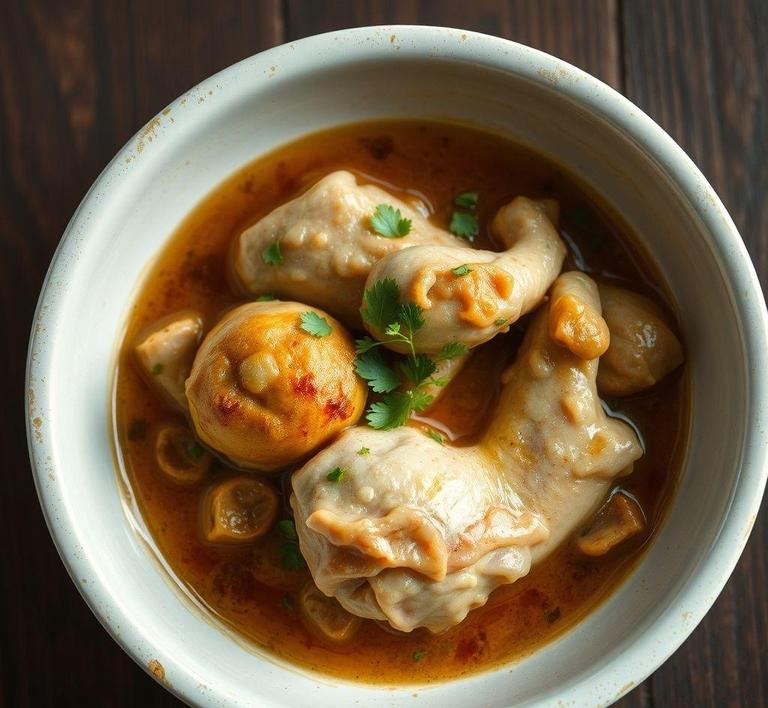If you’re like most people, you’ve probably made a big batch of chicken stew at some point, only to have leftovers piling up in the fridge. But don’t worry, you don’t have to throw it out! Refreezing chicken stew is a great way to make sure those leftovers don’t go to waste, and it can save you time on a busy weeknight. In this guide, we’ll walk you through everything you need to know about safely refreezing chicken stew, from how to store it properly to tips on preserving the flavor and texture. So, let’s dive in and make sure your stew stays fresh and delicious, even after a second freeze!
Can You Refreeze Chicken Stew?

When it comes to chicken stew, the question of whether you can refreeze it is a common one, especially in a household where leftovers are often stored for later use. The answer, however, isn’t entirely straightforward. Technically, yes, you can refreeze chicken stew, but with several important considerations to keep in mind to ensure both food safety and the quality of the stew remain intact.
The general rule of thumb when it comes to refreezing any food is that it’s safe to do so if the food hasn’t been left out at room temperature for more than two hours. As long as the stew was thawed in the refrigerator (not at room temperature) and has been handled properly, you can safely refreeze it. This is important because chicken stew, like any meat-based dish, can harbor bacteria if left out too long or improperly thawed, which can lead to foodborne illnesses.
However, there’s a catch with the texture and taste. Freezing, thawing, and refreezing can impact the consistency of the stew’s broth and vegetables. If you’ve already heated the stew before refreezing, the chances of a negative effect on the texture increase, especially with ingredients like potatoes or carrots that become mushy after being frozen and thawed repeatedly.
Thus, while refreezing chicken stew is technically safe as long as it’s done correctly, it’s more about balancing food safety with the potential effects on the quality of the meal.
How To Refreeze Chicken Stew?
To refreeze chicken stew properly, it’s essential to follow a few critical steps to avoid compromising both its safety and quality. Here’s a detailed breakdown of the process:
-
Ensure Proper Initial Freezing:
The first step to successful refreezing starts with how you freeze your stew initially. If you’ve made a fresh batch and plan on storing it, make sure to cool it quickly after cooking. This helps to prevent bacterial growth. Never leave it out at room temperature for more than two hours. To cool the stew faster, you can place it in shallow containers, which allow the heat to dissipate more quickly. If the stew is in a large pot, divide it into smaller portions to speed up the cooling process.
-
Thaw Correctly:
When you want to refreeze leftover stew, the first step is to thaw it correctly. The safest method for defrosting chicken stew is in the refrigerator. Allow the stew to thaw over a period of 12-24 hours depending on the quantity. While using a microwave or hot water might be quicker, it can affect the texture and safety of the dish, so these methods should be avoided.
-
Reheat to the Right Temperature:
Before refreezing, you should always reheat the stew to a boiling point (165°F or 74°C) to ensure that any potential bacteria present from the thawing process is eradicated. Stir well to ensure the heat is evenly distributed. If the stew has been left out for an extended period (longer than the recommended time), it’s best not to refreeze it.
-
Use Airtight Containers:
When refreezing, choose airtight containers that prevent air from getting inside and causing freezer burn. For best results, use vacuum-sealed bags or containers designed for freezing. Make sure to leave some space at the top of the container to allow the liquid to expand as it freezes.
-
Label and Date:
Don’t forget to label your containers with the date it was refrozen. This ensures you use it within a safe time frame (usually within 2-3 months). Freezing food for too long will cause it to lose quality, even if it remains safe to eat.
Quality Impact
While it’s perfectly safe to refreeze chicken stew as long as it’s done properly, there’s an undeniable impact on quality. The most significant issues involve the texture and flavor of the dish. Let’s break down the key quality changes that occur during the freezing and refreezing process:
-
Texture Changes:
The most noticeable change in refrozen chicken stew is the texture of the vegetables and meat. Freezing and thawing can cause water molecules inside the cells of vegetables (like carrots, peas, and potatoes) to expand, damaging the structure. This can make them mushy or limp once reheated. Similarly, chicken meat might become a bit drier or tougher after being refrozen, as the freezing process can cause moisture loss.
-
Separation of Broth:
Stews typically have a rich, flavorful broth. When frozen, the broth’s consistency can change due to the separation of fats and liquids. After refreezing and reheating, the broth might not be as smooth as it was initially. This can result in a more watery texture, and you might notice that the fat floats on top or separates in uneven chunks.
-
Flavor Alterations:
Refreezing can also alter the flavor of the chicken stew. Over time, even if the stew is stored correctly, the spices and seasonings can lose their potency. The stew might taste more bland or flat after being frozen multiple times, and some of the natural flavors might become less distinct. This is especially true if the stew contains ingredients like dairy, which can undergo changes in flavor when frozen.
-
Freezer Burn:
While freezer burn doesn’t make food unsafe to eat, it does have a negative impact on quality. It occurs when air comes into contact with the surface of the food, drying it out and creating tough, discolored patches. If chicken stew isn’t sealed properly when refrozen, it’s more likely to develop freezer burn, which can make it less appetizing.
While it is safe to refreeze chicken stew, it’s important to consider the trade-offs in terms of quality. As long as the stew has been properly cooled, thawed, and reheated to the appropriate temperature, you can freeze and refreeze it without worrying about safety risks. However, be mindful that the second freezing process will likely result in changes to the texture, flavor, and consistency of the stew. The vegetables may turn mushy, the broth could separate, and the overall taste may suffer.
If you’re okay with slight alterations in quality, refreezing chicken stew can be a practical solution for managing leftovers and reducing waste. But if maintaining the stew’s original texture and flavor is paramount, it might be better to stick to freezing it once, then consuming it within a reasonable time frame. Either way, ensuring that your chicken stew is stored and reheated correctly is key to preserving both safety and taste.
Is It Safe To Refreeze Chicken Stew?
Refreezing chicken stew is a topic that sparks considerable debate in culinary circles, largely because it involves both food safety and quality concerns. In general, refreezing chicken stew is safe as long as you follow proper guidelines. However, certain precautions must be taken to avoid both health risks and a decline in the stew’s taste and texture.
When you freeze chicken stew, the freezing process halts bacterial growth, ensuring that it remains safe to consume after a certain period. However, the safety of refreezing depends largely on the initial freezing conditions and how long the stew has been sitting at room temperature before you freeze it again.
If chicken stew has been defrosted in the refrigerator and has remained at a safe temperature (below 40°F or 4°C), it can generally be refrozen. However, if it was defrosted at room temperature for more than two hours, it should not be refrozen, as bacteria can multiply quickly at warmer temperatures, potentially leading to foodborne illness.
One critical factor to remember when refreezing chicken stew is how many times you have frozen and thawed it. Each time food is thawed and refrozen, its quality suffers. The texture of the chicken might become mushy, and the broth could lose its rich flavor, as some of the water content separates during freezing and thawing processes.
Signs That Chicken Stew Should Not Be Refrozen
Refreezing chicken stew is a good way to save leftovers, but there are specific signs to look for when determining if your stew should be discarded instead of refrozen:
- Sour Smell or Off Odor: If your chicken stew has a sour or rancid smell, it is an indication that it has spoiled. This could happen if it was left out at room temperature for too long or wasn’t stored properly in the fridge. If the stew smells bad, do not attempt to refreeze or consume it.
- Changes in Color: A noticeable change in color, such as the chicken turning gray or the vegetables becoming mushy, could be an indication of spoilage. While color changes don’t always mean food is unsafe, they can be an early sign of bacterial growth.
- Separation of Liquids: When chicken stew is frozen and thawed, some of the liquid might separate from the solid components, forming an unpleasant watery layer. If this separation looks abnormal (for instance, if the stew has large clumps of fat or oil floating on top), it may be best to discard it rather than refreeze. This can indicate that the stew was not frozen properly or has undergone multiple cycles of freezing and thawing.
- Texture and Consistency Changes: If the texture of the stew feels slimy or overly watery after thawing, it’s likely a sign of degradation in quality. Refreezing food that has already lost its texture will lead to an even worse consistency, making it unpleasant to eat.
- The Stew Was Left Out Too Long: If the stew has been sitting at room temperature for more than two hours (or more than one hour if the temperature is above 90°F or 32°C), bacteria may have grown to unsafe levels. Even if you refrigerate it afterward, this can be risky, and it should never be refrozen.
Common Refreezing Mistakes
Refreezing chicken stew isn’t an exact science, and mistakes can often lead to foodborne illnesses or ruined dishes. Below are some common mistakes to avoid:
- Refreezing After Leaving Stew at Room Temperature: This is perhaps the most dangerous mistake you can make. Leaving chicken stew out on the counter for several hours allows bacteria to multiply rapidly. If you refreeze the stew after this, you’re likely freezing a dish that is already unsafe to eat.
- Thawing Stew in Warm Water or Microwave: If you defrost chicken stew by using warm water or a microwave, you’re not allowing the stew to thaw evenly. These methods can cause the stew to remain in the temperature danger zone (between 40°F and 140°F), where bacteria thrive. The best way to thaw stew is by leaving it in the refrigerator overnight, where the temperature remains consistently cool.
- Freezing Stew in Large Batches: Freezing large amounts of stew at once can make it difficult to ensure that it freezes evenly and at the proper temperature. Large portions take longer to freeze, which can result in a compromised texture. It’s better to freeze the stew in smaller, meal-sized portions that can thaw and reheat more evenly.
- Improper Storage Containers: If you use containers that are not air-tight or freezer-safe, your chicken stew could develop freezer burn. This can result in a loss of flavor and texture, making it less appetizing. Always use high-quality freezer bags or containers that can maintain a tight seal.
- Not Labeling and Dating: It’s easy to forget when you put your chicken stew in the freezer, which can result in leaving it frozen for too long. The USDA recommends consuming frozen chicken stew within 4 to 6 months. After this time, the stew may still be safe to eat but will likely have a significant decline in flavor and texture.
Tips And Tricks For Refreezing Chicken Stew
To help ensure that refreezing chicken stew is safe and results in the best possible outcome, consider the following tips:
- Cool Stew Before Freezing: Before placing your chicken stew in the freezer, make sure it’s cooled to room temperature. Hot stew can raise the temperature of your freezer and lead to other items thawing, which could lead to contamination. If you’re in a hurry, you can cool the stew more quickly by placing the pot in an ice bath or dividing it into smaller portions.
- Use the Right Storage Materials: Opt for freezer-safe containers or heavy-duty freezer bags to store your chicken stew. Freezer bags are especially useful since you can squeeze out excess air before sealing. If using containers, choose those made for freezing to avoid cracking or breaking under the extreme cold.
- Label and Date: Always label each container with the contents and the date you froze the stew. This will help you track its age and ensure you use it within the recommended time frame.
- Refreeze in Small Portions: Freeze your chicken stew in smaller portions rather than large batches. This makes it easier to thaw only what you need, without repeatedly refreezing the entire batch, which could degrade the quality.
- Avoid Thawing and Refreezing Multiple Times: For the best taste and safety, limit the number of times you thaw and refreeze chicken stew. It’s always better to only thaw what you plan to eat and leave the rest frozen.
- Consider Freezing Ingredients Separately: If you plan to make chicken stew frequently, consider freezing the components separately (e.g., chicken, vegetables, broth). This way, you can combine the ingredients fresh each time, resulting in a better overall taste and texture.
Conclusion
Refreezing chicken stew is possible, but it requires careful attention to food safety and quality preservation. It’s essential to follow proper cooling, storage, and thawing techniques to ensure that your stew remains safe to eat. While refreezing can help reduce food waste and save time, keep in mind that multiple cycles of freezing and thawing will degrade the taste, texture, and nutritional value of the stew.
Always check for signs of spoilage and avoid refreezing if you suspect the stew has been improperly handled or stored. With the right precautions, you can enjoy a safe, tasty meal without any waste and make the most out of your leftovers.


